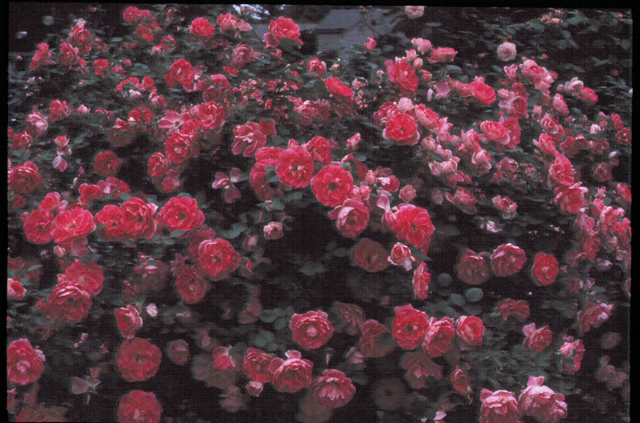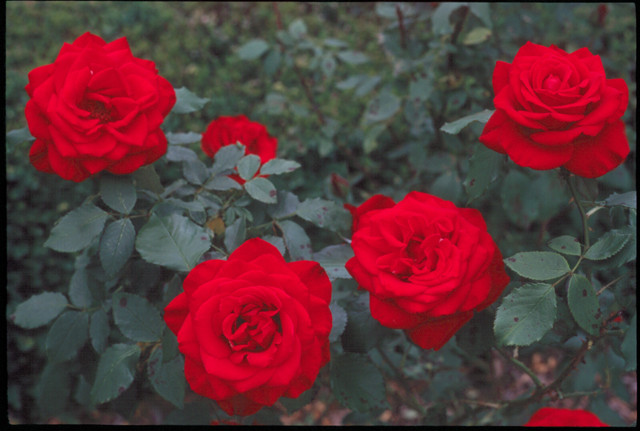Nature Photography: Mistakes and Corrections
Arizona pix | California pix | Toledo Botanical
Modern, high-performance digital and film cameras use sophisticated electronics, software and precision-ground lenses to re- produce the best possible representation of the actual scene or event. User or camera shortcomings can be further corrected using "post-production" software such as Adobe Photoshop Elements, Jasc PhotoShop Pro or GIMP (a superb, free open-source program).
Despite modern automation, no one will argue the importance of at-the-camera photographic mechanical/optical skills (use of filters, tripods, remotes) as well as a good grasp of camera or software manual-adjustment utilities. A bit of reading, in-the-field practice and a lot of throw-away shots (!!) are required. However, once you're comfortable with a few, basic skills you will shoot and manipulate images with outstanding results.
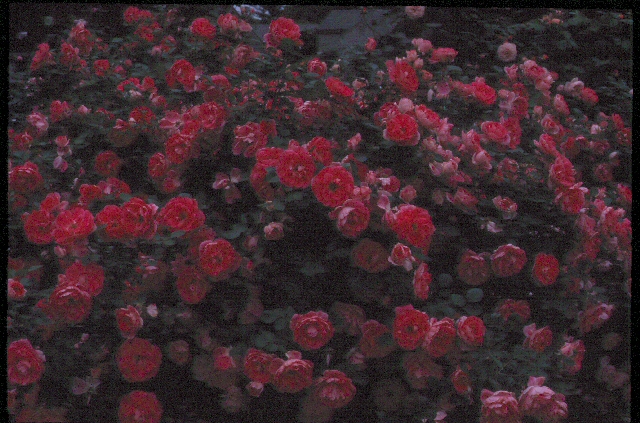
above: Under-exposed
rose bush at Toledo Botanical Gardens, Toledo, Ohio, USA: this picture
was photographed using Fuji Velvia film and an Olympus OM 2N SLR Camera
with a 28mm Zuiko lens. This was a windy day so a fast shutter
speed was deemed necessary...and used. Unfortunately, this photo was
taken very late (8 pm) on a dark, very overcast summer day. A combination
of low light and fast shutter speed -- as well as the low speed of
the Velvia film: ISO 50 -- led to the under-exposed effect seen above.
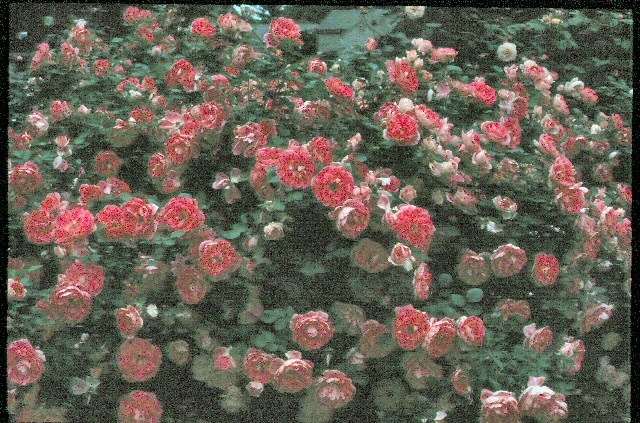
above: Under-exposed
rose bush at Toledo Botanical Gardens not correctable
using Jasc
Paint Shop Pro Version 8.10 and it's "One Step Photo Fix" utility.
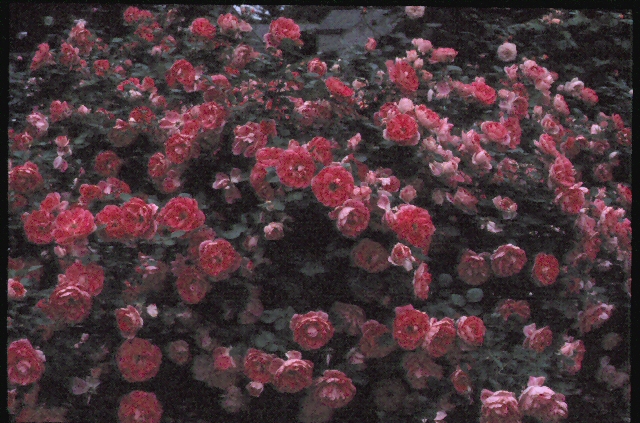
above: Under-exposed
rose bush at Toledo Botanical Gardens: Somewhat corrected manually
with Jasc
Paint Shop Pro Version 8.10.
above: Under-exposed rose bush at Toledo Botanical Gardens: Somewhat corrected manually using the incredible Adobe Photoshop Elements 2.0 program. Although Jasc may have been tweaked to look similar to this Photoshop image, I tried to keep tweaking times similar for both programs. This was what I came up with in the same amount of time as spent on the image immediately above this one. Given this criteria, Photoshop is a clear winner. Further tweaking and and/or use of more sophisticated photo programs (such as the full version of Adobe Photoshop) may lead to even better results -- such as reduction of "crushed" black-level detail, clearly needed in this image. However, the point of the discussion on this page is this: if you do it right the first time (see image below), you will have to do little or no "post-production" manipulation.
above: A close-up of roses at the same rose bush as in shots above. The wind gusts died down for a few seconds, allowing the use of a slightly longer exposure time. This image has not been "re-touched" in any way. The word re-touched is used in quotation; the lab technician that developed this transparency (slide) film probably made some personal choices during development. All photos on this page were scanned using a Hewlett-Packard PhotoSmart S20 scanner. Although this is a dedicated photo and transparency scanner, it is a comparatively inexpensive (and, now, relatively old; it was first available in 1998); it may be a limiting factor. That said, the over-saturated reds visible in this image were also pronounced in the original slide. Pure reds are traditionally a more-difficult hue to reproduce.
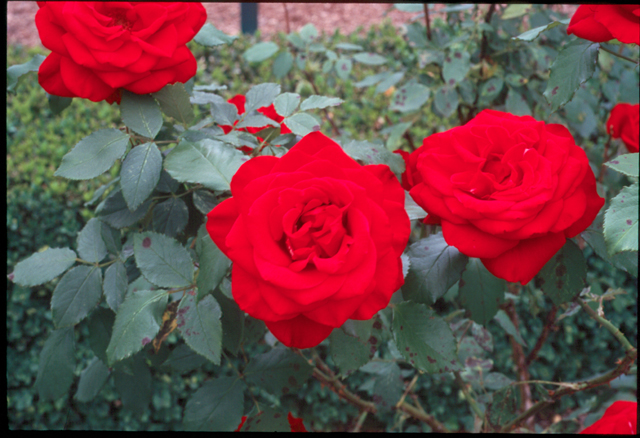
above: Raw image: Close-up of red roses without color correction. Note: the original image is over 7 megabytes in size; the image above is a bit over 283 kilobytes.
Although the original has greater resolution (noted in larger, blown-up
sizes) the reduction in scale (1:24.7) does not mean that the image you
see above is 24.7 times "less worthy".
This is just what the scanner outputs; some of it may, indeed, be worthless
noise. Modern graphics programs, such as Adobe
Photoshop , Jasc
PaintShop Pro and GIMP have
mathematical algorithms sophisticated enough to scale an image down
in size, without sacrificing color fidelity and saturation, hue accuracy,
and contrast and brightness "dynamics".
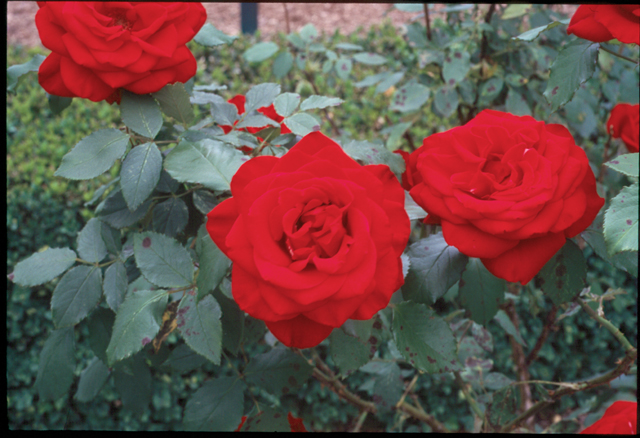
above: Close-up of red
roses -- same image as above -- with color correction, performed
in Adobe
Photoshop Elements. An additional layer was created and saturation
and hue were adjusted accordingly. There is a slight "blur"
visible. This was due to movements of the plants caused by wind currents.
A tripod is essential for serious imaging. Additionally, an object may
be braced ("anchored") by hand or a stick to further steady
the shot.
Home > Photography: Introduction | Mistakes
and Corrections | Color
Photography | Scanner
Photography | Astronomy
photos
Arizona
pix | California
pix | Toledo
Botanical
